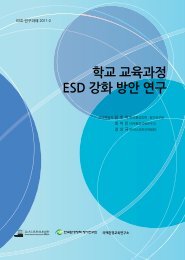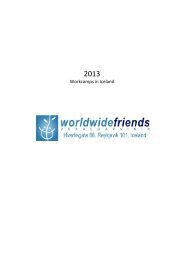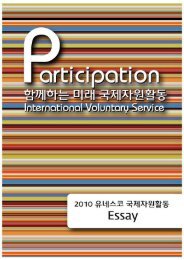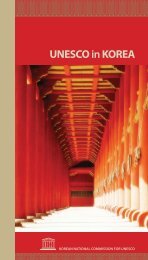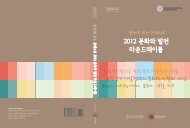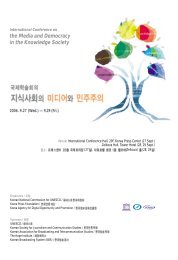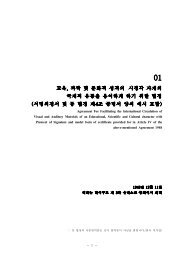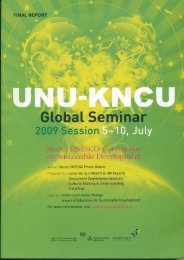DMZ ì¼ì ìí ííì ê´ë¦¬ë¥¼ ìí êµì 컨í¼ë°ì¤ - ì ë¤ì¤ì½íêµììí
DMZ ì¼ì ìí ííì ê´ë¦¬ë¥¼ ìí êµì 컨í¼ë°ì¤ - ì ë¤ì¤ì½íêµììí
DMZ ì¼ì ìí ííì ê´ë¦¬ë¥¼ ìí êµì 컨í¼ë°ì¤ - ì ë¤ì¤ì½íêµììí
You also want an ePaper? Increase the reach of your titles
YUMPU automatically turns print PDFs into web optimized ePapers that Google loves.
International Conference on Conservation and Peaceful Use of the Korea <strong>DMZ</strong><br />
north and lowlands are located in the west and south. It has about 3,700 mountains and<br />
peaks (Gong Woo-seok, 2006). Mountains cover about 70 percent of the Korean Peninsula<br />
and this area is affected by the East Asian monsoon and is surrounded by seas on three<br />
sides. Winters are cold and dry and summers are hot and humid. The annual rainfall is<br />
500 mm to 1,500mm and the total coastal line is around 11.352 km (islands and the North<br />
Korea included).<br />
With regard to forest and vegetation in the North, coniferous tree accounts for 41% of<br />
the total, broadleaf tree is 35.6%, and mixed forest of coniferous and broadleaf trees<br />
accounts for 22.5%. According to the 3 rd National Report on Biodiversity, 9,956plant species<br />
are registered for DPRK: seed plant 3,366 species, ferms 230, bryophyta 780, lichenes 580,<br />
fungi 2300 and algae 2,700. The number of animal species recorded in the nation is 9,970:<br />
vertebrates some 1,610 and invertebrates some 8,360(of them insects are some 5,960<br />
species).<br />
3. Hanbando Eco-Peace Park Initiative<br />
Society at large shares a vision for a peaceful and harmonious Korean Peninsula. A<br />
large scale biodiversity connectivity initiative in the Baekdu Daegan Mountain System<br />
(BDMS) would promote biodiversity, as well as reconciliation and regional stability.<br />
Despite the ROK law on the Protection of the BDMS, protection for this important<br />
mountain systemextends only along the southern region of the Korean Peninsulabounded by<br />
the <strong>DMZ</strong>. The Hanbando Eco-Peace Park (HEPP) Initiative, which would create a<br />
significant transboundary protected area (TBPA) from Mt. Seorak in the South to Mt.<br />
Geumgang in the North, through the <strong>DMZ</strong>, would be an invaluable and strategic tool for<br />
connecting the whole mountain range, thus creating an unbroken corridor for wildlife, for<br />
the first time since it was divided a half century ago.<br />
Other TBPA initiatives have been developed around the world to cooperatively establish<br />
and manage protected areas that cross national borders. IUCN guidelines and studies show<br />
that connecting these areas and creating wildlife corridors has led to increased ecosystem<br />
integrity and functioning, eco-tourism revenue, community identity and regional peace and<br />
security.<br />
In the past, there have been several proposals and efforts on the Korean Peninsulato<br />
create TBPAs across the <strong>DMZ</strong>. Regrettably all of them have no big outcomes, due to a<br />
combination of reasons: lack of effective dialogue between the two Koreas, the constraints<br />
of high level geopolitical disagreements, lack of cooperative and collaborative mechanisms<br />
with stakeholders, and/or overly ambitious agendas. It is clear, from the complex political<br />
situation and different ways of thinking between the two Koreas, that it would be extremely<br />
difficult to establish the whole <strong>DMZ</strong> area as a peace park at this moment. Therefore, to<br />
Nature, Peace and Local Development ❙ 51



